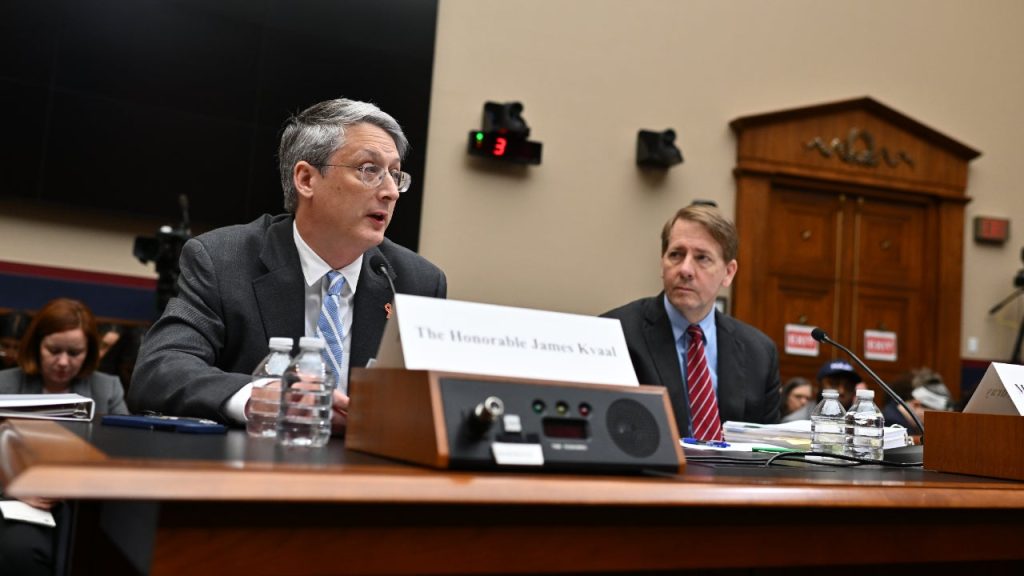On March 20, the day that President Trump signed an executive order to “shut down” the Department of Education, its top-ranking higher education official under the Biden Administration was at home, wearing a gray sweatshirt and a look of resignation.
“It’s hard to watch,” says former Education Department Under Secretary James Kvaal in an exclusive interview with Bankrate. “You expect some policy changes from one administration to the next, and you know that’s part of our system.”
This time, it’s different. Since taking office, the Trump Administration has targeted Public Service Loan Forgiveness (PSLF), blocked access to income-driven repayment plans and cut almost half of the department’s staff. Then came the order to dismantle it altogether (which would ultimately require an act of Congress).
“That’s hard on a human level,” says Kvaal, “but I’m also just really concerned about undoing all of these efforts to strengthen the department as an institution, which should not be a partisan issue.”
In our conversation, Kvaal expressed special concern about how changing winds could impact students and families pursuing higher education in the future, both near and far.
We need to find different ways to pay for college that don’t involve relying heavily on debt, and especially debt that is not associated with higher incomes [after graduation].
— James Kvaal, former under secretary of education under the Biden Administration
Bankrate’s interview with James Kvaal about paying for college
Our Q&A with Kvaal has been edited for length and clarity.
Now that you’ve been on the sidelines for a few months, how do you look back on your run as an under secretary?
A lot of what we did was really trying to strengthen the Department of Education as an institution and make it more capable of delivering on the promises that policymakers made to students. For example, in 2021, most students who were eligible to have their loans forgiven through one of the department’s programs were not able to navigate the bureaucracy. The FAFSA, of course, was another very visible example of the department struggling to administer its programs and get students the benefits they’re entitled to.
And a lot of the changes we made to strengthen the organization — to bring in much needed expertise in technology and contract management and other things — were among the half of the department that were just swept out of the door by the Trump Administration. I’m concerned [about] eliminating [the department] — not seeking to eliminate individual low performers, but eliminating… the areas where the deficiencies at the department contributed to the FAFSA challenges and contributed to sort of long-running problems in the student loan programs and other areas.
James Kvaal resume highlights
Kvaal was the under secretary of education under the Biden Administration through January 20, 2025. He was formerly the president of TICAS and the deputy director of domestic policy in the Obama Administration. He has served on the faculty at the University of Michigan’s Ford School of Public Policy and is a graduate of Stanford University and Harvard Law School.
Did the Biden Administration’s Education Department ever consider cuts to streamline the department?
Sure, and we did do some of those things. In fact, just last summer we reorganized FSA [Federal Student Aid] to better group the key functions together so that you could empower senior managers and hold them accountable. I don’t think that’s what’s happening now. The stated goal of this [new] administration is to close the department, so I don’t believe that these changes are being made with the goal of making the department more effective.
What does President Trump’s executive order tell you about how the new administration will handle federal student loan repayment?
We’ve heard a lot of skepticism from Republicans about whether student loan payments should be higher, whether Public Service Loan Forgiveness and other benefit programs should be less generous. So, although we haven’t seen specific proposals yet, I’m concerned that the administration… may not recognize how many people are really struggling with those loans.
The root cause of the country’s $1.6 trillion education debt is how we pay for school in the first place, and in a mid-January op-ed for Higher Ed Drive, you credited former President Biden with “beginning a new chapter” on that front. Putting the Trump Administration aside, what should the next chapter look like?
The sense around Washington is that there’s an agreement that a lot of students take out loans that we know they’re going to be challenged to repay and that… we need to find different ways to pay for college that don’t involve relying heavily on debt, and especially debt [for degrees] that is not associated with higher incomes.
College graduate salaries
Average salaries of college grads can vary widely based on degree and major.
The big disagreement is when you take away loans — do you put in other sources of financing as well? Loans are not always the right tool to help low-income students make up for financing gaps or to pay for people going into public service professions. But if we’re not going to use loans, then we do need to invest in Pell Grants and tuition-free programs and other ways to make sure that students can access higher education.
There are some good ideas circulating about cutting off programs that leave most of their students unable to repay their loans. There are some good ideas about investing in career technical education, and if those voices within the [Trump] Administration end up being the governing voices of administration policy, there could be an opportunity for progress there. But I don’t want to sound overly optimistic. It’s hard to sound optimistic here on a day in which President Trump is sign[ing] an executive order abolishing the department entirely.
As for “cutting off” colleges and universities for leaving their students deep in debt, how could that work in practice?
We looked very closely at what we call the debt-to-earnings ratio, which meant we would get real data on how much students borrowed; how much graduates earned; and if debt consumes too much of [their] earnings, we would consider that program to be unaffordable. And at that point, there are a variety of ways that colleges can respond: They could increase scholarships, reduce tuition; they could shorten programs; they could invest in improving career outcomes; they could invest in improving student retention.
It’s really a way to identify those programs where, at the low end, taking out loans are likely to leave you worse off than if you hadn’t gone [to the school] at all. [It would give] colleges an incentive to improve the value that they offer students, at least above that very low floor.
What about the issue of students and their families seeing debt-financed education as inevitable?
We need to recognize that college is not just about the “ROI” to the individual student and as a result, loans are not always the right way to pay for college. The Biden Administration created the Financial Value Transparency [FVT] framework, which would for the first time let students know, for whatever program they’re planning to attend, how much they can expect to borrow and how much they can expect to earn. And if those loans are considered unaffordable based upon expert guidelines, they’ll get warned about that too.
[FVT] is a good stepping-off point for broader conversations, and although I’m not sure the Trump Administration recognizes that greater investment should come in behind an effort to cut off these bad loans, I do see a lot of interest around the country in investing more in higher education. We’ve seen, finally, states investing more than they did prior to the Great Recession… and we’ve seen free-tuition programs in Maine and Massachusetts and Minnesota, Colorado and New Mexico.
So, [we are] turning the corner on the idea that we can just rely on ever-higher amounts of debt for all college students, and a recognition that some of these loans are not good investments and that more money is needed to help students go to college.
So if a student doesn’t see “financial value” of attending a college or university, they could be better skipping the typical four-year degree?
Well, we need more types of education after high school, and I’m a big believer in community colleges, which can offer two-year technical degrees that lead to a job… Even shorter certificate programs can also be an affordable way to get a start on a four-year degree.
Keep reading: How to maximize your learning while minimizing your debt
Overall, we need all of the above, all of those degrees and certificates. The evidence is there’s much more demand in the labor market for [more of] the kind of expertise than what Americans have, so we should be encouraging all those pathways. We shouldn’t encourage the four-year degree at the expense of students who want to get out in the workforce more quickly, but we do need to invest in all those options, encourage and raise our level of education attainment across the board.
Given everything we’ve discussed, what would you tell current and future students and their families about how to navigate today’s challenges of paying for their schooling?
The implications [of the Trump Administration] aren’t totally clear in some cases — there will be litigation — so there’s more uncertainty than there has been in the past.
What’s not uncertain is that, for most students, college is a great investment. Students need to do their research and not just assume that a loan is a good investment because the federal government is offering it. But I do think getting financial aid from the federal government, from colleges and other sources and going on to continue your education is as important as it’s ever been.
Read the full article here









